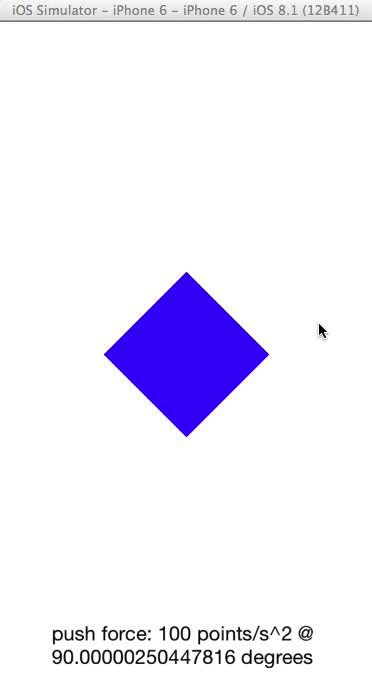# Titanium.UI.iOS.PushBehavior
Continuous or instantaneous force to apply to an item.
# Overview
A push behavior configures the continuous or instaneous force to apply to one or more items. To define a push behavior:
- Use the Titanium.UI.iOS.createPushBehavior method to create and define the behavior.
- To define a force vector, either set the Titanium.UI.iOS.PushBehavior.angle and Titanium.UI.iOS.PushBehavior.magnitude properties, or set the Titanium.UI.iOS.PushBehavior.pushDirection property.
- Use the Titanium.UI.iOS.PushBehavior.addItem method to add items to the behavior.
- Add the behavior to an Titanium.UI.iOS.Animator.
# Examples
# Simple Example
The following example generates a random push force on the block when it stops.

var win = Ti.UI.createWindow({backgroundColor: 'white', fullscreen: true});
// Create an Animator object using the window as the coordinate system
var animator = Ti.UI.iOS.createAnimator({referenceView: win});
var block = Ti.UI.createView({
width: 100,
height: 100,
backgroundColor: 'blue',
transform: Ti.UI.createMatrix2D({ rotate: 45 })
});
// Create a default collision behavior, using the window edges as boundaries
var collision = Ti.UI.iOS.createCollisionBehavior();
collision.addItem(block);
animator.addBehavior(collision);
// Push the block down when the application first starts
var push = Ti.UI.iOS.createPushBehavior({
pushDirection: {x: 0.0, y: 1.0},
pushMode: Ti.UI.iOS.PUSH_MODE_INSTANTANEOUS
});
push.addItem(block);
animator.addBehavior(push);
// Apply a new push behavior when the item stops
animator.addEventListener('pause', function(e){
push.angle = 2 * Math.PI * Math.random();
push.magnitude = Math.random() * 5 + 5;
push.active = true;
});
animator.addEventListener('resume', function(e){
Ti.API.info(JSON.stringify(
'push force: ' + push.magnitude * 100 + " points/s^2 @ "
+ (push.angle * 360 / (2 * Math.PI)) + " degrees")
);
});
// Start the animation when the window opens
win.addEventListener('open', function(e){
animator.startAnimator();
});
win.add(block);
win.open();
# Properties
# active
State of the push behavior's force.
Set to true to activate the force or false to deactivate it. Use this property rather
than removing and re-adding the behavior to the animator.
Default: true
# angle
Specifies the angle of the force vector in radians.
To configure the force vector, you need to also specify the magnitude property.
Default: 0
# apiName READONLY
The name of the API that this proxy corresponds to.
The value of this property is the fully qualified name of the API. For example, Titanium.UI.Button
returns Ti.UI.Button.
# bubbleParent
Indicates if the proxy will bubble an event to its parent.
Some proxies (most commonly views) have a relationship to other proxies, often established by the add() method. For example, for a button added to a window, a click event on the button would bubble up to the window. Other common parents are table sections to their rows, table views to their sections, and scrollable views to their views. Set this property to false to disable the bubbling to the proxy's parent.
Default: true
# magnitude
Specifies the magnitude of the force vector.
A value of 1.0 represents an acceleration of 100 points per second squared if the item is
100 x 100 points with a density of 1.0.
To configure the push vector, you need to also specify the angle property.
Default: 0
# pushDirection
Specifies the direction of the force vector as an x, y pair.
For example, specifiying {x: 0.0, y: 1.0} indicates a positive upward force of 100
points per second squared if the item is 100 x 100 points with a density of 1.0.
Specifiying a negative value reverses the direction of the force.
Default: (0,0)
# pushMode
Specifies the push mode.
Default: Titanium.UI.iOS.PUSH_MODE_CONTINUOUS
# Methods
# addEventListener
Adds the specified callback as an event listener for the named event.
Parameters
| Name | Type | Description |
|---|---|---|
name | String | Name of the event. |
callback | Callback<Titanium.Event> | Callback function to invoke when the event is fired. |
Returns
- Type
- void
# addItem
Adds an item to this behavior.
Parameters
| Name | Type | Description |
|---|---|---|
item | Titanium.UI.View | View object to add to the behavior. |
Returns
- Type
- void
# applyProperties
Applies the properties to the proxy.
Properties are supplied as a dictionary. Each key-value pair in the object is applied to the proxy such that myproxy[key] = value.
Parameters
| Name | Type | Description |
|---|---|---|
props | Dictionary | A dictionary of properties to apply. |
Returns
- Type
- void
# fireEvent
Fires a synthesized event to any registered listeners.
Parameters
| Name | Type | Description |
|---|---|---|
name | String | Name of the event. |
event | Dictionary | A dictionary of keys and values to add to the Titanium.Event object sent to the listeners. |
Returns
- Type
- void
# removeEventListener
Removes the specified callback as an event listener for the named event.
Multiple listeners can be registered for the same event, so the
callback parameter is used to determine which listener to remove.
When adding a listener, you must save a reference to the callback function in order to remove the listener later:
var listener = function() { Ti.API.info("Event listener called."); }
window.addEventListener('click', listener);
To remove the listener, pass in a reference to the callback function:
window.removeEventListener('click', listener);
Parameters
| Name | Type | Description |
|---|---|---|
name | String | Name of the event. |
callback | Callback<Titanium.Event> | Callback function to remove. Must be the same function passed to |
Returns
- Type
- void
# removeItem
Removes the specified item from this behavior.
Parameters
| Name | Type | Description |
|---|---|---|
item | Titanium.UI.View | Item to remove. |
Returns
- Type
- void
